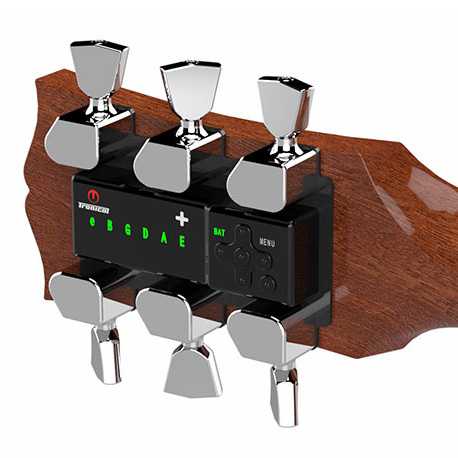Allgemein, Guitar Tuner, Polyphonic Guitar Tuner
Master Your Tuning with Polyphonic Guitar Tuners: A Comprehensive Guide
In the world of guitar tuning, precision and efficiency are paramount. While traditional tuners require tuning each string individually, polyphonic guitar tuners have revolutionized the process by allowing you to tune all strings at once. In this guide, we’ll explore the benefits, features, and uses of polyphonic guitar tuners, helping you master your tuning with ease.

Understanding Polyphonic Tuning: Polyphonic tuning technology enables guitarists to tune all strings simultaneously, saving valuable time and streamlining the tuning process. Unlike conventional tuners that analyze one string at a time, polyphonic tuners use advanced algorithms to detect the pitch of each string independently, displaying any deviations from standard tuning on a single screen. This innovative approach makes tuning quicker, more accurate, and less cumbersome, especially for players who frequently switch between alternate tunings.
Benefits of Polyphonic Guitar Tuners:
- Time-Saving Efficiency: With polyphonic tuners, you can tune your guitar in seconds rather than minutes, making it ideal for quick tune-ups during rehearsals, live performances, or recording sessions.
- Precision Accuracy: Polyphonic tuning technology ensures precise tuning across all strings, eliminating the need for repeated adjustments and fine-tuning individual strings.
- Easy to Use: Polyphonic tuners feature intuitive interfaces and user-friendly displays, making them accessible to guitarists of all skill levels, from beginners to seasoned professionals.
- Versatility: Whether you’re playing electric, acoustic, or bass guitar, polyphonic tuners can accommodate a wide range of instruments and string configurations, providing consistent tuning results every time.
- Performance-Ready: Polyphonic tuners are designed for use in live settings, with bright displays and rugged construction that can withstand the rigors of the stage.
Features to Look For: When choosing a polyphonic guitar tuner, consider the following features to ensure you find the best option for your needs:
- Display: Look for a tuner with a clear, easy-to-read display that provides visual feedback for each string, allowing you to quickly identify any tuning discrepancies.
- Calibration Options: Opt for a tuner that offers calibration settings to accommodate different playing environments and tuning preferences.
- Durability: Select a tuner with sturdy construction and reliable components that can withstand frequent use and travel.
- Battery Life: Check the battery life of the tuner to ensure it can keep up with your playing schedule without frequent battery changes or recharges.
- Additional Functions: Some polyphonic tuners offer extra features such as built-in metronomes, instrument inputs, or connectivity options, providing added value and versatility.

Conclusion: Polyphonic guitar tuners represent a significant advancement in tuning technology, offering unmatched efficiency, precision, and convenience for guitarists of all levels. By embracing polyphonic tuning, you can streamline your tuning process, improve your playing experience, and focus more on making music. Whether you’re jamming at home, performing on stage, or recording in the studio, a polyphonic guitar tuner is an essential tool that will help you achieve perfect pitch with ease.
Practical Tips for Using Polyphonic Guitar Tuners:
- Ensure Proper String Detection: To achieve accurate tuning results with a polyphonic tuner, ensure that each string is properly detected and displayed on the tuner’s screen. Check for any obstructions or interference that may affect the tuner’s ability to detect string vibrations, and adjust the positioning of the tuner if necessary.
- Check Tuning Across All Strings: While polyphonic tuners offer the convenience of tuning all strings simultaneously, it’s still important to verify the tuning accuracy of each individual string. Use the tuner’s chromatic mode or switch to single-string mode to double-check the tuning of each string and make any necessary adjustments.
- Monitor Battery Life: To avoid unexpected interruptions during performances or rehearsals, keep an eye on the battery life of your polyphonic tuner and carry spare batteries or a charger as needed. Regularly replace batteries or recharge your tuner to ensure reliable operation when you need it most.
- Experiment with Alternate Tunings: Take advantage of the versatility of polyphonic tuners by experimenting with alternate tunings to discover new sounds and expand your musical horizons. Whether you’re exploring standard alternate tunings like drop D or venturing into more exotic tunings, polyphonic tuners make it easy to dive into uncharted sonic territory.
In conclusion, polyphonic guitar tuners offer a wealth of benefits and applications for guitarists seeking efficiency, precision, and versatility in their tuning process. By harnessing the power of polyphonic tuning technology and incorporating practical tips for usage, guitarists can elevate their playing experience, unlock new creative possibilities, and achieve optimal tuning results with ease. Whether you’re a beginner learning the ropes or a seasoned pro pushing the boundaries of musical expression, a polyphonic guitar tuner is an indispensable tool that will enhance your playing journey for years to come.



